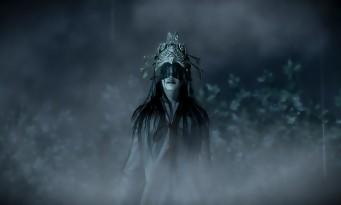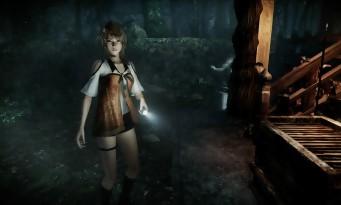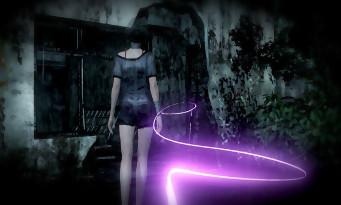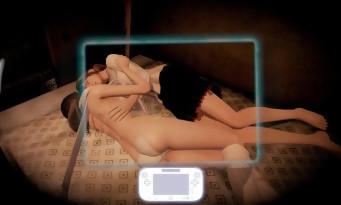 Dark stories of sacrificial rites in a place steeped in history. Glaucous environments. Appearances of more or less aggressive ghosts in the beam of a flashlight. And a camera as the only defense. The least we can say is that seen from here, this new Project Zero remains in the vein of its elders. It's Mount Hikami that will serve as the game's backdrop this time: a misty, sinister summit, where people come to commit suicide, while others simply disappear with their bodies and belongings. A perfect background to give birth to all kinds of legends and to attract occult lovers. It's a new wave of disappearances that will lead our three heroes, for different reasons, to explore Mount Hikami and delve into its dark past.
Dark stories of sacrificial rites in a place steeped in history. Glaucous environments. Appearances of more or less aggressive ghosts in the beam of a flashlight. And a camera as the only defense. The least we can say is that seen from here, this new Project Zero remains in the vein of its elders. It's Mount Hikami that will serve as the game's backdrop this time: a misty, sinister summit, where people come to commit suicide, while others simply disappear with their bodies and belongings. A perfect background to give birth to all kinds of legends and to attract occult lovers. It's a new wave of disappearances that will lead our three heroes, for different reasons, to explore Mount Hikami and delve into its dark past.THERE AND BACK AGAIN
 You will indeed control three different protagonists in turn depending on the chapter of the game, as was already the case in the series. Each will shed additional light on what is really going on on Mount Hikami, the secrets of which you will unearth as you push your exploration of the place a little further. The game will indeed ask you to return several times to the same places, at different times to advance the pitch and unlock access to a new sector. A form of repetitiveness that will not necessarily appeal to all players, but which has the merit of reinforcing the unity of place and time, despite the recurring returns to the café in which Yuuri works between expeditions. With this slow pace, this new component guarantees a very good lifespan, if only to go to the end of the adventure, without necessarily talking about scoring and replayability. But honestly, the incessant back and forth, including within levels, is not the main problem that this fifth main installment of Project Zero suffers from.
You will indeed control three different protagonists in turn depending on the chapter of the game, as was already the case in the series. Each will shed additional light on what is really going on on Mount Hikami, the secrets of which you will unearth as you push your exploration of the place a little further. The game will indeed ask you to return several times to the same places, at different times to advance the pitch and unlock access to a new sector. A form of repetitiveness that will not necessarily appeal to all players, but which has the merit of reinforcing the unity of place and time, despite the recurring returns to the café in which Yuuri works between expeditions. With this slow pace, this new component guarantees a very good lifespan, if only to go to the end of the adventure, without necessarily talking about scoring and replayability. But honestly, the incessant back and forth, including within levels, is not the main problem that this fifth main installment of Project Zero suffers from.HIKAMIQUETTES
 The series now jointly managed by Nintendo and Tecmo has indeed not evolved in the same way as other famous horror licenses. For example, it did not follow Resident Evil's turn towards action. No, Project Zero is pure horror, an atmosphere very inspired by Japanese genre cinema, The Ring in mind, with particular care given to lighting and sound design, which constantly maintain the tension. without resorting too regularly to the ease of jump scare. Dark forest paths and crazy glauquitude, labyrinthine and gloomy traditional buildings, caves that ooze humidity and unease: this is what awaits you in this title with a successful atmosphere, which will succeed in sticking to you without any problem. the micttes (much more so than our heroes, surprisingly impassive in the face of events that would have made Fox Mulder himself run wild).
The series now jointly managed by Nintendo and Tecmo has indeed not evolved in the same way as other famous horror licenses. For example, it did not follow Resident Evil's turn towards action. No, Project Zero is pure horror, an atmosphere very inspired by Japanese genre cinema, The Ring in mind, with particular care given to lighting and sound design, which constantly maintain the tension. without resorting too regularly to the ease of jump scare. Dark forest paths and crazy glauquitude, labyrinthine and gloomy traditional buildings, caves that ooze humidity and unease: this is what awaits you in this title with a successful atmosphere, which will succeed in sticking to you without any problem. the micttes (much more so than our heroes, surprisingly impassive in the face of events that would have made Fox Mulder himself run wild).THE PHANTOM PAIN
 However, the fact that the series has not opened up to different genres also implies a much more problematic technical immobility. The filthy textures, the framerate drops beyond two characters on the screen, the lack of renewal in the sets, the expressionless faces: ầ the limit, still passes. Especially since the heavy atmosphere can easily make us forget cosmetic concerns. And then hey, developing on Wii U, we know it's not easy every day... However, it's hard to ignore the rigor mortis of the movements, the apathetic camera (even when it's pushed to the max of its sensitivity) and especially on the messy character of the fights with the camera, whose objective is now on your GamePad. A choice as wobbly as it is interesting.
However, the fact that the series has not opened up to different genres also implies a much more problematic technical immobility. The filthy textures, the framerate drops beyond two characters on the screen, the lack of renewal in the sets, the expressionless faces: ầ the limit, still passes. Especially since the heavy atmosphere can easily make us forget cosmetic concerns. And then hey, developing on Wii U, we know it's not easy every day... However, it's hard to ignore the rigor mortis of the movements, the apathetic camera (even when it's pushed to the max of its sensitivity) and especially on the messy character of the fights with the camera, whose objective is now on your GamePad. A choice as wobbly as it is interesting.The idea of using the GamePad and its gyroscope is not fundamentally bad. But combined with the annoying handling of the game, it generates particularly disastrous fights
 As in previous episodes, the heroes therefore conjure the spirits they face using a Camera Obscura, a mystical camera that you can customize within a certain limit during the game. This will also be used to solve little puzzles, activating mechanisms and unlocking doors, for example by reproducing a photo in a given place. The combat system remains the same as before: aim for weak points in the spectrum to split it into fragments; the more targets you have in the objective, the more damage you will do, in a sort of combo. The idea of using the GamePad and its gyroscope to let the player better frame his photo is not fundamentally bad. But combined with the annoying maneuverability of the game, it generates particularly disastrous fights in small perimeters, which are legion in the game. Fortunately, the health objects are scattered everywhere and you would really have to be inattentive to hit a Game Over, at least in Normal mode. If you do not hang on to the story or the atmosphere, it is not the fights, without any real progression curve, that will encourage you to prolong the adventure.
As in previous episodes, the heroes therefore conjure the spirits they face using a Camera Obscura, a mystical camera that you can customize within a certain limit during the game. This will also be used to solve little puzzles, activating mechanisms and unlocking doors, for example by reproducing a photo in a given place. The combat system remains the same as before: aim for weak points in the spectrum to split it into fragments; the more targets you have in the objective, the more damage you will do, in a sort of combo. The idea of using the GamePad and its gyroscope to let the player better frame his photo is not fundamentally bad. But combined with the annoying maneuverability of the game, it generates particularly disastrous fights in small perimeters, which are legion in the game. Fortunately, the health objects are scattered everywhere and you would really have to be inattentive to hit a Game Over, at least in Normal mode. If you do not hang on to the story or the atmosphere, it is not the fights, without any real progression curve, that will encourage you to prolong the adventure.

























